“I returned next morning for more photography and documentation of predated nest, since there hasn’t been any nest measurement records made available in text to my knowledge. It was a rain free night.
“All photographs taken that morning were hand-held, close- up shots.
“This is the first morning photograph taken of the predated nest, the way left the evening before (below left).
“The nest was located in secondary mixed forest suspended in thicket bush of withered, browned ferns, 96cm off ground. Domed shape weaved strongly by fine roots, it has a side east facing entrance that caught the morning sunray. Sloped angle from ground floor to nest measured approximately 20 degrees elevation.
“Angle view of nest showing more forensic details of disarray and fragmented twigs for good measure provided here (above right). This will be the last photograph readers get to see before I clear away foliages and other debris surrounded, to reveal full extent of nest for measurement.
“Here is view of nest’s image executed standing up with camera directing almost over subject. A well defined igloo shaped, root interwoven roof top after external loose debris and fallen foliages removed is revealed here (below left).
“The excellent and well constructed nest is shown here with following exterior measurements (above right): Semi-circumference of outer dome-41cm (Green): Entrance opening horizontal length-12cm (Red): Entrance opening maximum vertical height-6cm (Yellow).
“In squat position, a close-up view of entrance opening into nest chamber is documented here to show magenta, bluish staining of its chamber and reinforced floor of dried foliages (below left).
With right hand palm, I gently pushed the roof top aside to reveal more of the empty chamber (above right).
“Only after upon this action, could the nest chamber be seen whole. Should there be chicks present, they probably be huddling together and their numbers accounted for. In other words, photography to show full view of chicks in Pitta’s nest of such is NOT possible unless roof top of nest gets manually maneuvered.
“The nest was so well interwoven as not to tear apart easily and definitely no ill wind could blow off nor could a toddler’s hand the strength to flip over the roof lid in a jiffy.
“Predators with claws or paws that could have yanked the nest’s lid off would have left nothing in nest chamber for any cozy chicks to be photographed.
“The top view or town’s view shows all with a maximum internal chamber’s width and depth of 18cm each measured with surveyor’s rule. Documentation shot in my standing position and camera held directly over the nest posted here (below left).
“I took to a squat position for a closer observation and side view of the nest for the last time. It showed all the intricacies of a Blue-winged Pitta’s (Pitta moluccensis) nest (above right, below left).
“Remnant feathers left behind by predator/predators estimated to be total of one chick and age over a week old were collected and returned to nest chamber for burial (above right, below).
“This final scene in ‘Go’ zone left behind, showed the forest floor trodden by me alone over two trips (up and downX2) is useful forensic image. The 0923hs. morning sunray that penetrated the forest floor also shone my exit path (left).
“One can only imagine the vegetative state of the site if a dozen of birders/photographers or more would descend daily upon a newly discovered Pitta site.
“I left the burial site led out by the morning benevolent ray.
“But…. I am not done yet. The B-W Pitta pair- Scarlet and P10 continued to impress and gave more revelations.”\
“To be continued…”
Avian Writer Daisy O’Neill
Penang, Malaysia
6th November 2013
Copyright article and all copy images – Courtesy of Daisy O’Neill Bird Conservation Fund


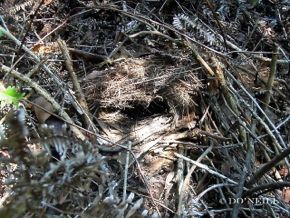


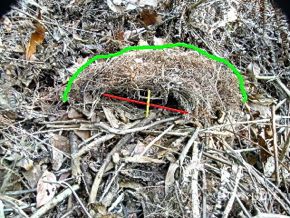
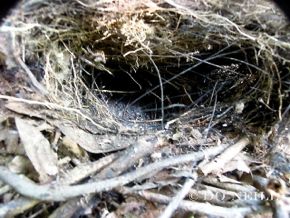



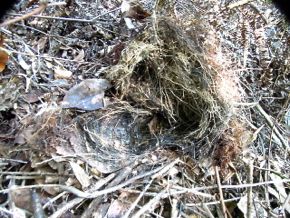

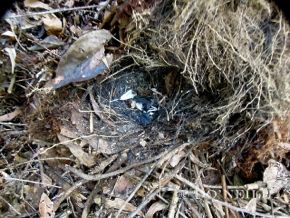
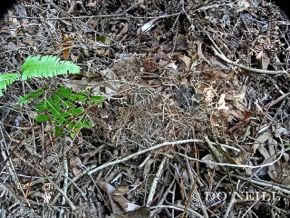








2 Responses
In Nature observations, curiosity & persistence are the ingredients required to get ro the truth. Congratulations Daisy! Any idea who murdered the chicks?
I got one eyeball on the Leopard Cat -the other on the Feral cat. Feline predation usually leaves behind remnant feathers similar to those YV Bulbuls lost to feral cats’ predation in my balcony. The YV Bulbuls that have been frequenting and nesting in the past are fearful to renest on the macramé plant hanger these days.
Cheers!
Daisy